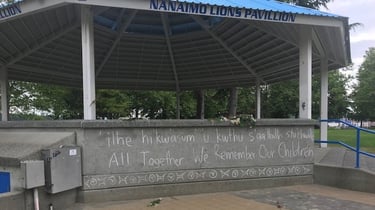Handling Tough Questions About Denialism
There isn’t a single public school in Canada or in the United States that features a graveyard out back next to the football field. [1] Grand...

Trigger Warning: This article includes information about Residential School experiences
In May 2021, the remains of 215 young Indigenous children were found in a mass grave at the site of the former Kamloops Indian Residential School. While the school may have closed down in 1969 (and the last school in Canada closed in 1997), this news has brought the tragedy of the residential school experience to the forefront of the minds of Canadians and the world. Reactions from the federal, provincial and municipal governments have poured in, along with public outcry for further action.

We wanted to share what you can do to ensure that every child is recognized and accounted for. There are many ways to support Indigenous communities every day, here is a list of what you can do today to show your support:
Many are calling upon their local government to potentially find more unmarked and undisclosed graves as a result of the conditions of residential schools. Call, or write to your local member of parliament (MP) to have more sites looked into, to ensure all children can "go home".
Among other issues that Indigenous people face in this country to this day, clean drinking water is still causing major health issues to 126 nations and remote communities in Canada. It is an essential part of life and something we cannot take for granted.
According to the 2016 census, one in five Indigenous people lived in a dwelling in need of major repairs. Unsafe or crowded living conditions can cause major health problems and are a constant and recurring issue for many communities.
Many municipalities have lowered their flags in response to the discovery and resulting news coverage of the 215 children. Prime Minister Justin Trudeau has asked that all federal buildings follow suit.

Orange Shirt Day falls on September 30 every year, however, now more than ever, wearing orange to support Indigenous children (those who made it home, or not) is a simple way to support communities. You can purchase an orange shirt from Orange Shirt Day, and partial proceeds go toward the foundation and awareness activities.
If you have not already, check out our different ways to continue showing support and sign our pledge.
It took many years following former Prime Minister Stephen Harper’s apology for Canada to complete the TRC’s report. In order to further understand the tragedy of Residential Schools, and the impact they have on communities today, the report accounts testimonials from survivors, and their experience attending these schools.
The Truth and Reconciliation Commission of Canada released their Calls to Action in 2015. So far, only 10 have been met. Please read the full document here and continue to practice the actions toward reconciliation. Share with friends and family. Further your research and learning through our Indigenous Relations Academy courses.
The United Nations Declaration of the Rights of Indigenous People is a comprehensive document outlining the different rights given to all Indigenous Peoples of the World. It is a defining piece of legislation that Canada is working towards implementing.
The IRSSS is a British Columbian society that provides counselling services to survivors and descendants of the Residential School experience and relies on the support of individuals to continue providing that support. Check out their website to learn more, and find out other ways to help.
Looking to do even more? Consider asking questions of church officials about their knowledge of reconciliation. Encourage faith leaders to enact and participate in reconciliation. Share this article with your family and friends, support more Indigenous-led community organizations, stand up against stereotyping and continue to practice empathy and patience.
Featured photo: Shutterstock

There isn’t a single public school in Canada or in the United States that features a graveyard out back next to the football field. [1] Grand...

Power is in tearing human minds to pieces and putting them together again in new shapes of your own choosing. George Orwell, 1984

I wrote this article because I frequently see postings on Facebook asking people to “like” the “Merry Christmas” greeting and denounce the “Happy...